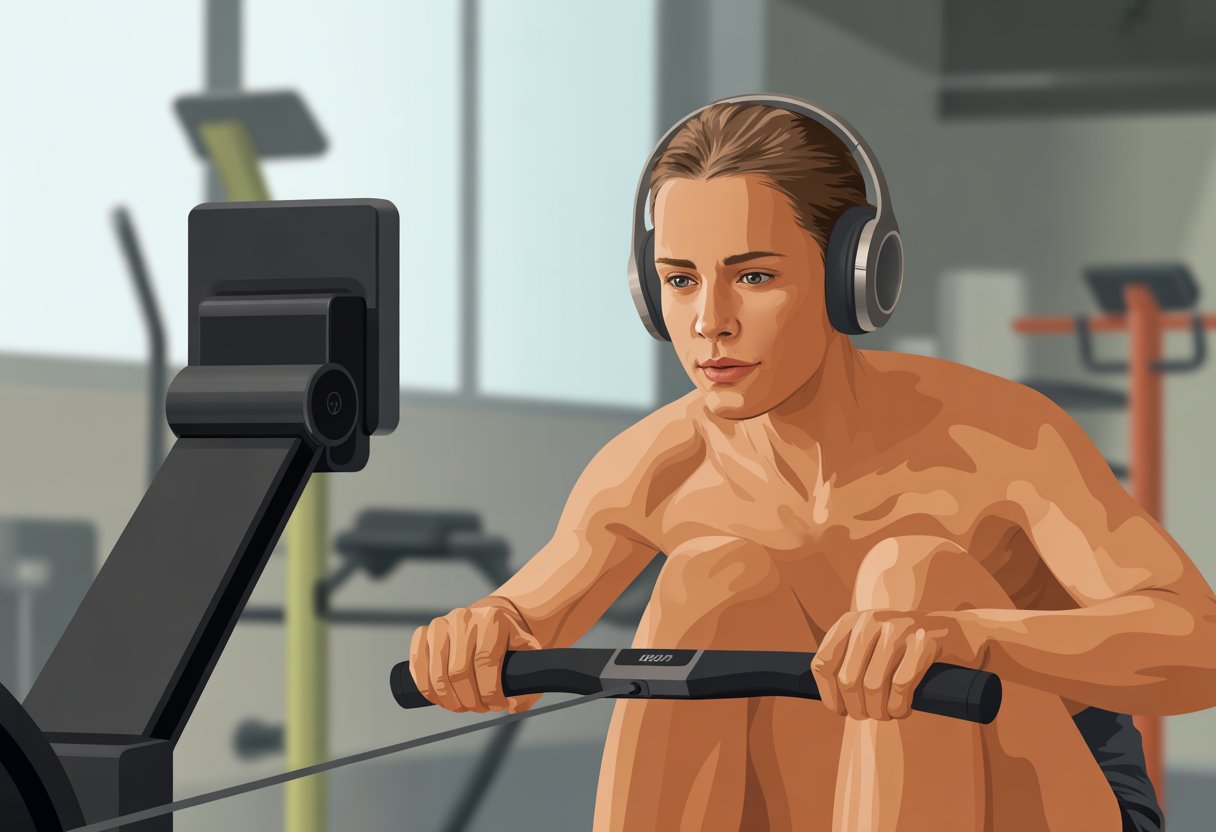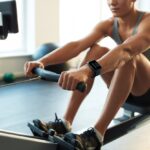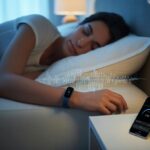Let’s be real—rowing machines are fantastic for cardio, but who wants to listen to their own huffing and puffing the whole time? Pairing Bluetooth headphones with rowing workouts can totally change the vibe.
Just connect your wireless headphones to the machine’s Bluetooth, and suddenly your sweat session feels way more enjoyable.

No more wrestling with cords or worrying about earbuds going airborne during a sprint. Bluetooth lets you row to your favorite playlists, podcasts, or even some calming nature sounds (because, honestly, who doesn’t want fake loons in their living room?).
Ready to make your indoor rows more fun and block out all that gym noise? Let’s break down how to pair those magical headphones and get the beats rolling.
Before You Pair: Check Compatibility
Before you get hyped for your playlist, take a second to avoid tech headaches. A few quick checks now can save you from silent, frustrating workouts.
Determine If Your Rowing Machine Supports Bluetooth
Let’s dodge the classic “Why isn’t this working?” moment. Not every rowing machine knows how to party with Bluetooth headphones.
Check for a Bluetooth icon on your machine or glance through the manual. Sometimes there’s a button, sometimes it’s buried in the settings.
Smart HD touchscreens almost always support Bluetooth, but older machines might just have an audio jack—or nothing at all.
If you’re stumped, hop on the rowing machine’s website or call customer support. No shame in asking, “Does this thing do Bluetooth, or am I out of luck?” Machines like the Hydrow show you how to activate Bluetooth right from the main menu.
Review Supported Wireless Headphones
Not all headphones play nice, and some rowing machines can be a bit picky. Make sure your headphones are compatible.
Most machines like Bluetooth headphones, but some only support certain Bluetooth versions or brands.
Check these things:
- The Bluetooth version on your headphones (4.0, 4.1, 5.0—those are common)
- How many devices your headset remembers—clear out old connections if needed
- Can you get into pairing mode easily? (Usually, you hold the power button until it blinks like crazy.)
AirPods sometimes act up if they’ve hit their device limit or need a reset. For more help, check out headphone compatibility issues.
Consider Smart HD Touchscreen Features
If your rowing machine has a smart HD touchscreen, you’re in luck. These usually make connecting wireless headphones a breeze.
Most touchscreens have simple pairing menus. Sometimes, the hardest part is deciding if you want to row or just mess with the tech.
With machines like Ergatta or Hydrow, just tap into settings, pick “Bluetooth Audio,” and let the touchscreen walk you through it. Some screens might need a weird sequence (like tapping the profile screen a bunch) to unlock secret menus, so check the manual or troubleshooting guides.
Smart displays can show you battery levels, signal strength, or even offer troubleshooting tips right there. Your ears—and your patience—will appreciate it.
How to Connect Bluetooth Headphones to Your Rowing Machine
Connecting wireless headphones to your rowing machine doesn’t have to be rocket science. A few steps, a couple taps, and you’re off—playlist blasting, motivation up.
Let’s make Bluetooth easy, not stressful.
Step-by-Step Bluetooth Pairing Process
First, double-check that your rowing machine actually supports Bluetooth. Not all machines do, so look for the Bluetooth symbol or dig into the settings.
Here’s what to do:
- Turn on your headphones. Keep them close—Bluetooth doesn’t like long-distance relationships.
- On the rowing machine, head to the settings or audio options.
- Select ’Add New Device’ or ‘Pair New Device’. The machine will start scanning for nearby gadgets.
- When your headphones pop up on the screen, tap them. Some headphones (especially AirPods) might need you to press an extra button—just follow the prompts. If you get stuck, this step-by-step guide can help.
You’ll probably hear a chime or see a message that you’re paired. If not, don’t sweat it—we’ve all yelled at machines before.
Troubleshooting Common Connection Issues
Sometimes Bluetooth headphones and rowing machines act like they’re feuding. Here’s how to handle the drama:
- Headphones not showing up? Make sure they’re not already paired with your phone or tablet.
- Still no luck? Turn off Bluetooth on other nearby devices and try again.
- AirPods or another stubborn pair? Reset them by holding the charging button or following the manufacturer’s steps.
- Interference: Wi-Fi routers, microwaves, and other electronics can mess with Bluetooth. Try moving things around.
If nothing works, turn everything off and back on. It’s basic, but hey, it works more often than not. If you need more help, check your rowing machine’s help section or browse FAQs like this one.
Reconnecting After Initial Setup
Bluetooth loves to play hard to get after the first time. Usually, you won’t need to pair your headphones every time. Most rowing machines remember them.
If they forget, here’s what you do:
- Make sure your headphones are on and close by.
- Open the rowing machine’s Bluetooth or audio menu.
- Pick your headphones from the previously connected devices list.
- Hit ‘Connect’ and wait for the happy beep.
Sometimes machines make you pair again, but usually a quick scan does the trick. If you connect headphones to your phone at the same time, the rowing machine might get jealous—stick to one device at a time.
With a little patience, you’ll be rowing to your favorite jams in no time.
Optimizing Audio Performance While Rowing
Let’s be honest—powering through a tough row with great music is unbeatable. But between the whoosh of air, sliding headphones, and muffled sound, getting crisp audio can feel like another workout.
Reducing Interference From Air Resistance
That flywheel can get loud fast, drowning out your music. The whoosh can turn your favorite songs into background noise.
Headphones with active noise cancellation or a snug in-ear design help block out wind noise, even during sprints.
If you’re not ready to splurge, try headphones with foam or silicone tips—they help keep air out. Position yourself so your ears aren’t right in the path of the flywheel. Moving a noisy fan or putting a mat under the machine can also help cut down the racket.
Adjusting Volume and Sound Quality
It’s tempting to just crank the volume, but your ears will thank you if you use other tricks. Many wireless headphones have built-in equalizers—use them! Adjusting bass and treble can keep vocals clear even with the rowing noise.
Set your device’s volume before you start, and do a quick test row to find the sweet spot. Going too loud for long sessions can leave your ears ringing. If your headphones have a “transparency” or “awareness” mode, turn it off for a more immersive sound.
If you want more control, try using a Bluetooth button attached to the handle or frame. Skipping tracks or changing volume without stopping your workout is a game changer.
Choosing Ergonomic Headphones for Comfort
Cool-looking headphones that fall off every few strokes? Useless. Ergonomics matter—pick headphones with secure hooks, ear fins, or over-ear designs to keep them in place, no matter how wild your rowing gets.
Sweat resistance is non-negotiable. Look for IPX7 or IPX8 ratings so you don’t fry your headphones halfway through a session. Soft ear pads are a lifesaver for long rows—avoid anything that pinches or gets itchy.
Fit is everything. Try different eartip sizes for a snug seal that blocks outside noise and boosts sound quality. Brands love to brag about “ergonomic design,” but the real test is surviving a sweaty 2,000-meter sprint.
When comfort and function come together, you spend less time adjusting headphones and more time focusing on your form.
Maximizing Your Rowing Experience With Apps and Data
Rowing isn’t just about pulling harder—it’s about rowing smarter. The right apps and data tools help you track progress, enjoy better music, and geek out over stats (maybe a little too much).
Using the Hydrow App With Bluetooth Audio
The Hydrow app feels like having a coach and a stereo in your pocket. Pair your Bluetooth headphones with the rowing machine and the Hydrow app for cord-free workouts.
No more tangled messes when you’re chasing a personal record or dodging a rogue oar.
Here’s how to set it up:
- Turn on your headphones.
- Make sure Bluetooth is on for your device.
- Open the Hydrow app and pick your audio device.
You’ll get live classes or scenic rows, all while tuning out the world—and maybe a family member who thinks they’re hilarious.
Syncing Your Workouts With Strava
Sharing your rowing wins? Strava is the spot. By connecting your rowing data to Strava, every meter gets counted.
You can sync your sessions automatically, join virtual clubs, and compare stats with friends (even those who claim they row more than they actually do).
To connect:
- Link your rowing app or machine account to Strava.
- Do your workout as usual.
- Watch your data transfer faster than your last sprint.
Strava gives you weekly, monthly, and yearly summaries, so you’ll know if your new routine is turning you into a superstar—or just a little less winded.
Exploring Data Visualization and Heart Rate Monitoring
Fitness data doesn’t mean much if we can’t actually make sense of it. These days, rowing machines and fitness apps bombard us with charts, graphs, and those color-coded zones that supposedly explain our effort. Some setups even let us connect heart rate monitors via Bluetooth, so we can watch our pulse jump around in real time.
Visual dashboards show us stroke rate, speed, distance, and calories burned—including the ones we might immediately replace with a snack after rowing. Heart rate zones keep us honest, so we don’t push too hard or accidentally slack off.
When we use advanced features like data visualization and heart rate monitoring, indoor rowing sessions suddenly feel way smarter. It’s like unlocking a new level, honestly.
Advanced Pairing With Popular Fitness Rowers
If we want to blast music or answer a call while rowing, we have to make sure our headphones connect smoothly to the machine. Each brand has its own quirks, so let’s check out a few specific models.
Connecting Headphones to the Peloton Row
Peloton keeps Bluetooth pairing pretty painless, as long as we stick to the right steps. First, we power up our headphones and put them in pairing mode—usually by holding a button until a light blinks.
Once the headphones are ready, we turn on the Peloton Row’s screen and head to the settings menu. There, we tap “Bluetooth Audio” or just “Bluetooth” (Peloton can’t seem to pick one). Then we pick “Add New Device” and wait for our headphones to show up.
We select our headphones from the list, and that usually does it. Sometimes, for extra fun, we might need to enter a pairing code—think 0000 or 1234, nothing wild. If the audio sounds off, just unpair and try again. Bluetooth loves a little drama, doesn’t it?
Pairing With the RW900 Rower
With the RW900 from NordicTrack, the process changes a bit. We still start by putting our Bluetooth headphones in pairing mode. Next, we tap the screen and open the settings.
We look for “Audio Settings” or “Bluetooth Audio”—sometimes it hides, just to keep us on our toes. When our headphones finally appear in the available devices list, we tap them to connect.
If things don’t go as planned, turning off and on both the RW900 console and our headphones can help. Bluetooth can be moody and usually just needs a quick reset. For more detail, this official step-by-step tutorial can walk us through it.
If it takes a few tries, don’t sweat it—Bluetooth can be stubborn before our actual workout even begins.
Customizing Rowing Machine Settings for Audio
To really enjoy our playlists or podcasts while rowing, we need to tweak our machine’s settings a bit. A few smart changes cut down on distractions and help keep our headphones where they belong.
Adjusting Resistance Levels for Minimal Vibration
Cranking resistance up feels epic, but too much power can turn our rower into a vibrating monster. That extra vibration can mess with Bluetooth audio or even shake headphones right off.
Starting with a moderate resistance and checking the audio while rowing helps a lot. If our headphones bounce more than we do, it’s probably time to ease up. Finding that sweet spot makes the ride smoother and the sound much clearer.
If our rower uses magnetic resistance, we’re in luck—there’s usually less shaking compared to air resistance. We should also make sure the machine sits on a flat surface or put a mat underneath. Less shaking means fewer headphone mishaps.
Configuring Power and Audio Sync
Nothing ruins a workout faster than audio lagging behind our strokes. Power cycles, interference, and distance can all mess with Bluetooth. If our rower sits next to a Wi-Fi router or a curious cat, it’s even trickier.
We press the Bluetooth pairing button (often called “Audio Output” or “Bluetooth Audio”) on the workout screen. Most machines let us pick “Pair new device” so we can add headphones or speakers—Hydrow’s guide for Bluetooth pairing shows exactly how.
Pro tip: Keep wireless headphones charged and make sure the rowing machine’s power cord is plugged in tight. Weak batteries or loose power can make Bluetooth glitchy. If nothing else works, restart both the machine and the headphones—sometimes tech just needs a quick “time out.”
Practical Tips for a Convenient Bluetooth Rowing Workout
When we use Bluetooth headphones with a rowing machine, comfort and sound can depend on where we set up the rower and how we get coaching or music. Small tweaks to our setup and training can really improve our workouts—and spare our ears.
Using Transport Wheels for the Best Listening Spot
Finding the right spot for rowing isn’t just about impressing the dog or cat. Thanks to transport wheels, moving a rowing machine feels more like steering a cart than dragging a boulder.
We should pick a place away from noisy appliances and echo-prone walls. Bluetooth works better without big obstacles, so let’s skip cramming the rower between bookshelves or under low ceilings. Living rooms or open spaces usually give us a better wireless signal.
A few quick tips:
- Check Flooring: Hard floors make rolling smoother (and quieter).
- Distance to Electronics: Too many gadgets can mess with Bluetooth.
- Sunlight: If we row near a window, remember—hot sun and glare don’t mix well with headphones.
Rolling the rower to the center of the room only takes a minute, and hey, we might even get a few bonus steps on our trackers.
Integrating Instruction From a Personal Trainer
Trying to follow a personal trainer while rowing used to be a mess—tangled cords everywhere, or yelling over static. But now with Bluetooth headphones, we actually hear coaching cues, technique tips, and those little pep talks, instead of just our own labored breathing. It’s honestly a game changer. Clear audio makes it so much easier to focus.
If your trainer coaches you through a video app, just connect your headphones to the rower’s screen, or straight to your phone or tablet. These days, most rowers let you pick an audio device from their Bluetooth settings right on the setup screen.
A few tips for keeping things smooth:
- Set Up Before Rowing: Seriously, fumbling with Bluetooth modes while you’re perched on the rower? That’s a workout by itself.
- Test the Connection: Ask your trainer to say something goofy first, just to make sure the audio’s coming through.
- Volume Check: Start low, then bump it up so you don’t blast your ears or miss anything important.
Bluetooth headphones make following a trainer hands-free—and honestly, there’s no excuse left not to. If only they could row for us too, right?
- Why is my fitness tracker not pairing with Apple Health? Troubleshooting for Technologically Cursed Mortals - December 22, 2025
- Why is my fitness tracker not updating firmware? Tech Tantrums and Update Woes Explained - December 21, 2025
- Why is the Sound Quality on My Bluetooth Headphones Poor? It’s Not Just Bad Music Taste! - December 21, 2025






